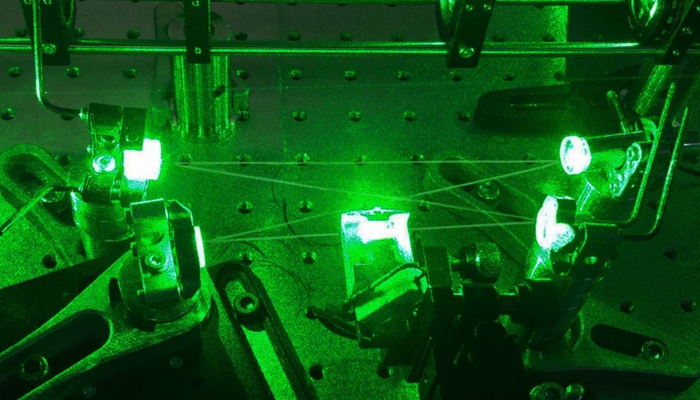Researchers from Macquarie University have discovered a novel and practical approach to Brillouin lasers with output power already ten times higher than all other Brillouin lasers.
Brillouin lasers rely on an effect in materials in which light and sound strongly interact to provide light amplification. To date, though, such lasers have been low power, and often seen as a curiosity. Indeed, in many systems the light-sound interaction is seen as a nuisance because the effect spoils laser system performance when increasing power.
Diamond is a particularly interesting material for this type of laser for two key reasons. Its high thermal conductivity means it is possible to make miniature lasers that simultaneously have high stability and high power. The speed of sound is also much higher compared with other materials. This gives the laser a secondary ability to directly synthesise frequencies in the hard-to-reach millimetre wave band.
In an article published in Applied Physics Letters Photonics this week, the researchers show that the light-sound interaction is particularly strong in diamond, and have demonstrated the first bench-top Brillouin laser that uses diamond.
This result is a breakthrough as it provides a highly practical approach to Brillouin lasers with a greatly increased range of performance. In contrast to earlier Brillouin lasers, the diamond version operated without having to confine the optical or sound waves in a waveguide to enhance the interaction. This means Brillouin lasers can be more easily scaled in size and with much greater flexibility for controlling the laser properties as well as increasing power.

Brillouin diamond laser
Diamond provides a new way to begin to exploit the unique properties of Brillouin lasers. Only a very small amount of waste energy is deposited in the sound-carrying material. This leads to a host of features including beam generation with ultra-pure and stable output frequency, the generation of new frequencies, and potentially, lasers with exceptionally high efficiency.
Macquarie University’s Rich Mildren says “This development provides a new pathway towards high power lasers that are extremely efficient and have exquisite frequency properties such as low-phase noise and narrow linewidth. These are properties needed for applications that demand the highest standards of noise-free frequency properties, like ultra-sensitive detection of gravitational waves or manipulating large arrays of qubits in quantum computers.”
Another ground-breaking outcome is that the diamond can synthesise very pure frequencies beyond the microwave band. As a consequence of the very high speed of sound in diamond – a dashing 18 km/s – the frequency spacing between the input pump beam and the laser line is many times higher than in other materials. This property can be used to generate frequencies in the millimetre wave band (30-300 GHz) using a technique called photo-mixing. Brillouin laser synthesis of these frequencies is important because there is an intrinsic mechanism that reduces the frequency noise to the levels needed by next-generation radar and wireless communication systems. This has been a major challenge for electronics or other photonic-based generation schemes.
The work so far has quantified the strength of the light-sound interaction in diamond, a fundamental parameter for predicting future design and performance. It also demonstrated a practical device with over 10 W of power.
Dr Zhenxu Bai, lead PhD student on the project, says “We can now begin to think about the design of Brillouin lasers in a new way, rather than as a phenomenon limited to small guided wave structures or as a detrimental effect in fibre lasers.”
The authors are concentrating their future work on expanding the range of laser capability by demonstrating lasers with the higher levels of frequency purity and power needed to support future progress in quantum science, wireless communications and sensing.



